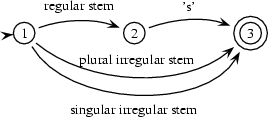3.1 Morphology
Morphology is about the inner structure of words. It is interested in what are the smallest units in word that bear some meaning and how can they be combined to form words.
First, what are meaning bearing units? You can say that the word rabbits has to two units which contribute to the meaning of the word: rabbit contributes the main meaning, and s adds the information that the word is plural. The smallest unit in a word that bear some meaning, such as rabbit and s, are called morphemes. Morphemes like rabbit that contribute the main meaning of a noun, verb, etc. are also called stems, while the other morphemes are also known as affixes.
The second question is then, how can morphemes be combined to form words that are legal in some language. Two kinds of processes can be distinguished here. They are called inflection and derivation. Inflection is usually taken to be the process of adding a grammatical affix to a word stem, forming a word of the same class as the stem. Adding plural s to a noun stem, for example, is an inflectional process. Derivation is when adding an affix to a word stem results in a word with a class different from that of the stem. Making a noun out of a verb by adding ation to the verb is an example: realize + ation gives us realization.
Let's look at the example of inflection of nouns in English in more detail.Basically, English nouns only come in two forms: singular and plural. In the standard case, you get the plural form by adding an s to the end of the noun stem, which, at the same time, is the singular form of the noun: rabbit vs. rabbits. However, there are some exceptions, where the plural is not built by simply adding an s to the stem, but rather by changing the stem: foot vs. feet. So, valid English nouns consist of either the stem of a regular noun, or the singular stem of an irregular noun, or the plural stem of an irregular noun, or the stem of a regular noun plus an s.
The nice thing about these morphological rules, is that they can be captured using finite state techniques. Which means that you can draw a finite state automaton describing the inflectional morphology of English noun phrases. Here it is:

And this is even true for languages which have a much richer morphology than English, Finnish for example.
There is one more complication, however, and that is that sometimes, when two morphemes are combined, additional changes happen at the boundary. When combining the noun stem fox, for instance, with the plural morpheme s we get foxes instead of foxs. That is, an e slips in between the stem and the suffix. The same things happens with stem kiss, which becomes kisses when adding the plural morpheme. This inserting of es at the morpheme boundary is not arbitrary though. It follows a rule, which says: ``Insert an e when a morpheme ending in s, x or z is combined with the suffix s.'' As we shall see in the next section this kind of rules can also be expressed using finite state technology.